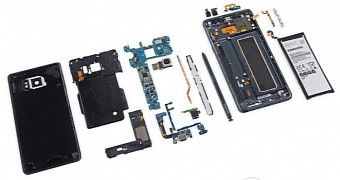Samsung has released its latest flagship, the Galaxy Note 7, today in the US and Canada, and the smartphone is well received on the market, considering that the South Korean giant has already announced limited stock for some color variants and delayed the release in some markets. What's more, the device has already been subjected to various durability tests and even teardowns.
iFixit has subjected the Galaxy Note 7 to a teardown to determine how the handset ranks on the repairability scale. The iFixit team gets new smartphones and other devices shortly before or after their release and determines how repairable the said units are. The Galaxy Note 7 has ranked 4 out of a 10 scale of repairability, with one point more compared to the Galaxy S7.
This means that the smartphone has a higher chance of getting repaired in case of damage as compared to units in the S7 line. Considering that the Galaxy Note 7 is water-resistant and has a non-removable back, it was to be expected that it would rank so low on the repairability scale.
The Galaxy Note 7 scored a 4 out of 10 on the repairability scale
The teardown reveals all the components found inside the smartphone, starting with the wireless charging coil and the NFC antenna. The 3,500mAh battery was securely set in place inside the phone and took a little extra carefulness to get out.
The video also shows the motherboard with all three of its cameras. The Galaxy Note 7 comes with a 5MP selfie camera and the IR scanner camera used for iris scanning, a technology believed to be more powerful than the fingerprint scanner.
The scanner is a two-part system with an infrared blaster to light up the eye while the sensor captures the image of the user's iris. The motherboard comes with 64GB of internal storage and 4GB of RAM, as well as the Qualcomm Snapdragon 820.
The Galaxy Note 7 scored 4 out of 10 because many components are modular and can be replaced, and the charging port board can be removed without disassembling the display. But on the downside, the front and back glass makes the phone vulnerable to cracks, and it's nearly impossible to replace the front glass without destroying the display.

 14 DAY TRIAL //
14 DAY TRIAL // 